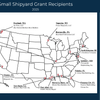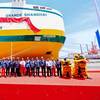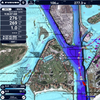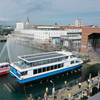Effectively Assessing Your Risks
Experience and expertise are the key factors in designing a successful strategy to serve the maritime market, which is made up of skilled professionals who know their business from A to Z. Vessel owners also are proud of their company history. For instance, they jump at the chance to show off models of their vessels, current units and those that have achieved the status of razor blades. Many are named after beloved family members and reflect a company's heritage - specifically how it has grown and continued to operate over the years.
Through relationship building and personal attention to our maritime clients, Summit Bank has learned of family and business disputes, failures and natural disasters. This is an industry where the perils are quite real and the emphasis on safety is a universal theme. In fact, a good safety record is a vital factor of which some members of the industry are justifiably proud. Listening to weather conditions signifies much more than planning a summer vacation, because hurricanes and storms can have an intimate impact. For this industry, the weather too often becomes an issue of crisis management — rescue at sea, a sinking vessel, pumping sand back onto the beach.
Nevertheless, in the maritime industry we often hear of good growth ideas that require financing. Part of risk assessment is deciding whether a particular financing opportunity represents a "bankable" risk. Bankable relationships with a customer often last for many years and are rewarding for both parties. A good banking relationship includes many dimensions that can span several life stages of either the business or the people involved in running the business. A good banker seeks to understand the long-term strategy and the financial needs of a customer in order to structure the appropriate financial growth plan. Such a plan may also involve acquisitions and mergers, estate planning, and succession issues for management.
Some financing opportunities may represent a huge upside potential involving the fulfillment of lifelong dreams and aspirations. However, high reward potential comes with an inherently large downside risk. Such opportunities are coined "unbankable" by traditional bank debt vehicles such as lines of credit, revolvers and term loans. Traditional bank products may earn interest and fees, but they are not structured to compensate for these potential downside risks. Specifically, they are not structured to share in the financial upside of the project if, or when, the owners succeed in the business venture. These opportunities may, instead, represent a risk that is more appropriately funded with equity from investors, or through a private placement or other capital market services.
Let's say a banker makes a loan for $1 million. If that loan becomes uncollectible and deemed a write off, it will take $50 million at a two percent spread over a one-year period to make up the difference. An offset of this magnitude represents a costly mistake in risk management. The duration of a loan is another factor in assessing risk. The longer the term, the greater the risk. Part of a banker's job is to match loan repayment with the appropriate asset life and cash flow. Generally, it is more beneficial to finance short-term assets with a short-term loan or line of credit, or to finance longer-term assets with term debt. However, some of the equipment used in the marine industry has a very long asset life. In these cases, a bank may seek to limit the risk imposed by a lengthy amortization requirement with a short-term balloon payment.
Maritime companies have financing needs that are unique. Their needs may be substantially large due to a variety of circumstances: the necessity to enlarge the fleet with new or used vessels; acquisition of another company; or a greater loan than the bank will normally finance. Under these circumstances, it may be appropriate for the customer's lead bank to arrange a "club" or "syndicated" loan. A club loan is usually a loan held by two to three banks. A syndicated loan may be larger in size and include up to 10 banks or more in the group.
Customarily, maritime customers use sophisticated capital markets products to finance various long-term growth opportunities. Privately placed long-term mezzanine loan and/or equity can be used to support a management buyout, a large acquisition or other substantial financing needs. Longer-term debt and equity can help a business weather a downturn.
For maritime business success, bankers must be aware of the uniqueness of the industry and determine what is a "bankable" deal in order to effectively meet the important challenge of correctly assessing and managing risk.
Summit Bank's Marine and Surface Transportation (MAST) group offers specialized lending expertise to companies within the maritime and transportation industries, as well as a full range of financial services, including equipment leasing, cash management and personal banking. A division of Summit Commercial, MAST focuses exclusively on serving the needs of maritime customers in this specialized industry by providing the experience, resources and flexibility to recommend the best industry-specific banking solutions that meet the company's strategic short and long term goals. Coflexip Stena Awarded $58 Million Contract One of Coflexip Stena Offshore's U.K. entities was awarded a large EPIC contract worth $58 million by BG International for its Blake subsea field, offshore Scotland at a depth of 295 ft. (90 m).
Situated approximately 9.5 km North of the Ross field in the Moray Firth, the Blake field will be tied-back to the existing Ross FPSO Bleo Holm, operated by Talisman.
Work scope for the project includes the installation of all the subsea structures and control system, including a manifold with six production wells gathered around, as well as two satellite water injection wells.
The engineering, manufacturing and installation of all the flowlines (rigid reeled, pipe in pipe, flexible) and umbilicals for the infield and tie-back connections; and the disconnection/reconnection of the FPSO that will be towed to and back from a conversion yard during Summer 2001. NASSCO Awarded $230 Million Contract National Steel and Shipbuilding Company (NASSCO), was granted a $230 million contract to build its eighth large, medium-speed RoRo vessel per the U.S. Navy's Strategic Sealift Program.
The contract wraps-up the 20-vessel LMSR Program that NASSCO has shared with other U.S. shipbuilders. The company now has contracts for 11 vessels, three conversions and eight new constructions.
Measuring 950 ft. (289.5 m) and containing 390,000 sq. ft. of cargo carrying space, the vessel's construction will commence this summer for mid-2002 delivery. MacGregor Elevators Featured On Cruise Newbuilds MacGregor's passenger ship division recently raised its orders to 146 for installation of its elevators on cruise and ferry newbuilds in German yards. The latest contract encompasses a 21-elevator shipset for Norwegian Cruise Line's 78,000-gt newbuild project Sky II currently on order at Lloyd Werft shipyard.
Five cruise vessels on order at Meyer Werft also boast MacGregor's elevators, such as P&O's Aurora; RCI's Radiance of the Seas and a sistership hull; Star Cruises' Superstar Libra and its 112,00-gt newbuilding.













